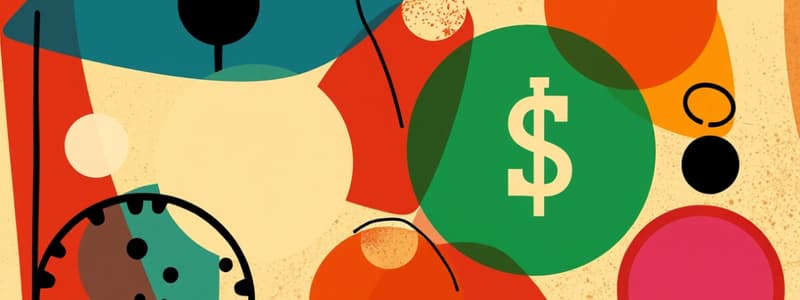Podcast
Questions and Answers
What does the marking indicate for someone copying an invention?
What does the marking indicate for someone copying an invention?
- They can claim ownership of the invention.
- They could be liable for damages. (correct)
- They are excluded from patent laws.
- They may receive a royalty payment.
What is the primary purpose of a trademark?
What is the primary purpose of a trademark?
- To exclusively identify the source of products or services. (correct)
- To allow customers to find the best prices.
- To provide legal protection to unpublished works.
- To indicate the expiration date of a product.
What does the symbol ® signify?
What does the symbol ® signify?
- The product is a registered service mark.
- The trademark is pending approval.
- The trademark has been approved by the U.S. Patent and Trademark Office. (correct)
- The product is under copyright protection.
What does the symbol © represent?
What does the symbol © represent?
What is the main function of a service mark (SM)?
What is the main function of a service mark (SM)?
What characterizes sustaining innovation?
What characterizes sustaining innovation?
Which of the following is NOT a typical aspect of sustaining innovations?
Which of the following is NOT a typical aspect of sustaining innovations?
Which group is often most successful at creating sustaining innovations?
Which group is often most successful at creating sustaining innovations?
What characterizes disruptive innovation?
What characterizes disruptive innovation?
Which of the following is an example of process innovation?
Which of the following is an example of process innovation?
What is a key difference between architectural and modular innovation?
What is a key difference between architectural and modular innovation?
Which scenario is an example of modular innovation?
Which scenario is an example of modular innovation?
What constitutes configurational innovation?
What constitutes configurational innovation?
The iPod is considered a successful example of which type of innovation?
The iPod is considered a successful example of which type of innovation?
In what way can architectural innovations be characterized?
In what way can architectural innovations be characterized?
Why is modular innovation often seen as an incremental change?
Why is modular innovation often seen as an incremental change?
What are the three main steps involved in designing an artifact with selected components?
What are the three main steps involved in designing an artifact with selected components?
What is the term for the delay in adopting an innovation due to competition with a dominant design?
What is the term for the delay in adopting an innovation due to competition with a dominant design?
Who is responsible for taking an invention to market and financing its development?
Who is responsible for taking an invention to market and financing its development?
Which of the following best defines a dominant design?
Which of the following best defines a dominant design?
What characterizes a product champion?
What characterizes a product champion?
Which type of innovator often feels isolated due to their commitment to novel ideas?
Which type of innovator often feels isolated due to their commitment to novel ideas?
Which of the following statements about an inventor is accurate?
Which of the following statements about an inventor is accurate?
What can lead to the suppression of innovation in the market?
What can lead to the suppression of innovation in the market?
What is the main difference between an invention and an innovation?
What is the main difference between an invention and an innovation?
Which is NOT one of Rogers' five stages of diffusion of innovations?
Which is NOT one of Rogers' five stages of diffusion of innovations?
What are some advantages of a multi-disciplinary team in innovation?
What are some advantages of a multi-disciplinary team in innovation?
What term describes technology that is available but too expensive for consumer use?
What term describes technology that is available but too expensive for consumer use?
What is a characteristic of planned obsolescence?
What is a characteristic of planned obsolescence?
Which stage follows growth in the product life cycle?
Which stage follows growth in the product life cycle?
What does the term 'technology push' refer to?
What does the term 'technology push' refer to?
Which of the following represents a disadvantage of multi-disciplinary teams?
Which of the following represents a disadvantage of multi-disciplinary teams?
What does market pull refer to in product development?
What does market pull refer to in product development?
Which of the following best describes technology transfer?
Which of the following best describes technology transfer?
What is the significance of market analysis in product design?
What is the significance of market analysis in product design?
Which factor does NOT typically drive invention?
Which factor does NOT typically drive invention?
Why might products that do not meet national and international standards struggle in the marketplace?
Why might products that do not meet national and international standards struggle in the marketplace?
Flashcards are hidden until you start studying
Study Notes
Intellectual Property Markings
- Marking notifies those copying an invention of potential liability for damages and royalties post-patent issuance.
- Trademark (™) signifies a recognizable sign or expression distinguishing products/services of a trader prior to approval by the U.S. Patent and Trademark Office.
- Registered Trademark (®) indicates a trademark approved by the U.S. Patent and Trademark Office.
- Copyright (©) grants creators exclusive rights to original works for a limited time, ensuring protection and compensation for intellectual efforts.
- Service Mark (SM) identifies a service rather than a product.
Categories of Innovation
- Sustaining Innovation: Incremental improvements to existing solutions, typically by large companies, resulting in feature fixes, cost reductions, and product line expansions (e.g., iPhone updates).
- Disruptive Innovation: Innovations that change market dynamics, making existing solutions obsolete, such as the iPod transforming music consumption.
- Process Innovation: Introduction of improved production or delivery methods, including new techniques and equipment (e.g., Dell’s custom-built computers).
Strategies for Innovation
- Architectural Innovation: Changes the overall architecture of a product without altering its components, considered a radical change (e.g., integrated devices like all-in-one PCs).
- Modular Innovation: Maintains product architecture while modifying internal components, representing incremental change (e.g., upgradable PC towers).
- Configurational Innovation: Involves predefined components configured to meet specific requirements, affecting both technology and organization.
Innovation Challenges
- Suppression Innovation: Delayed adoption of innovations competing with dominant designs due to factors like patent disputes and competitive threats.
- Dominant Design: Features recognized as essential by manufacturers and consumers, exemplified by products like Coca-Cola and Sony Walkman.
Inventor Roles
- Inventor: Creates new and novel ideas or products through discovery and technical advances.
- Entrepreneur: Finances and brings an invention to market.
- Product Champion: Advocates for an idea within an organization.
- Lone Inventor: Works independently on inventions, often facing isolation due to resistance to change.
Differences Between Innovation and Invention
- Innovation: Successful market application of an idea.
- Invention: Creation of a novel idea; not necessarily successful in the market.
Rogers' Diffusion Theory
- Innovations diffuse through cultures over a series of stages: knowledge, persuasion, decision, implementation, and confirmation.
- Adoption of an innovation progresses through a hierarchy of potential user groups.
Multi-Disciplinary Teams
- Advantages: Necessary for complex products, combining expertise from various disciplines to optimize resources.
- Disadvantages: Individual agendas can complicate decision-making and slow progress.
Technology and Market Dynamics
- Shelved Technology: Available technology that is too expensive for consumer use.
- Product Life Cycle: Stages include introduction (launch), growth, maturity, and decline.
- Planned Obsolescence: Deliberate design of products with limited lifespans.
- Technology Push: Manufacturers promote new products, anticipating consumer demand (e.g., lasers, synthetic diamonds).
- Market Pull: Demand-driven product development.
Economic Considerations
- Supply and Demand: Relationship between product availability and market demand.
- Technology Transfer: Adoption of technology across different fields (e.g., laser technology in surgery).
- Economic Viability: The ability of an activity to sustain itself financially.
- Market Analysis: Evaluates the financial prospects of a design, focusing on potential users and costs.
- National and International Standards: Products often require compliance with standards to gain market acceptance.
Drivers of Invention
- Motivations include creativity, scientific curiosity, constructive discontent, financial gain, and altruism.
Studying That Suits You
Use AI to generate personalized quizzes and flashcards to suit your learning preferences.




